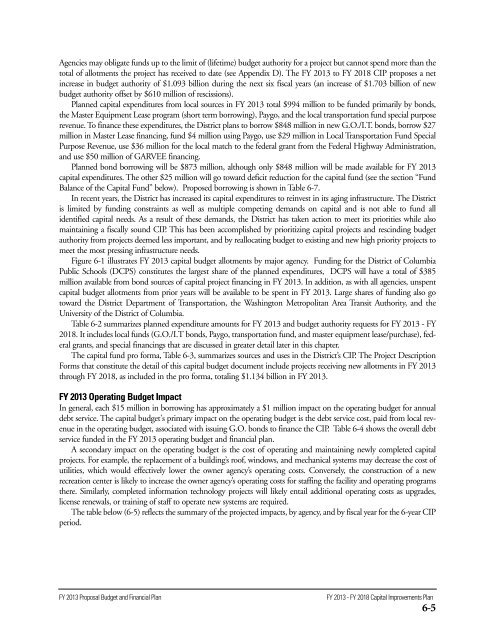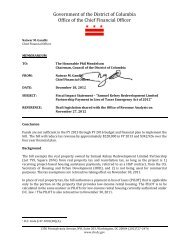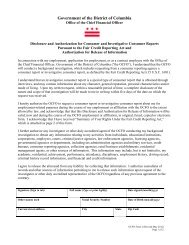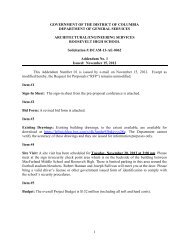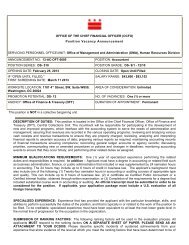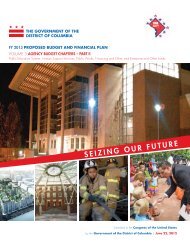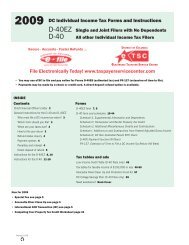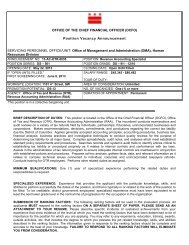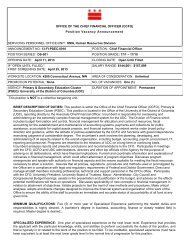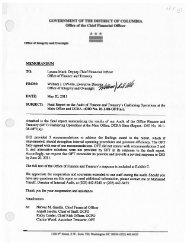Agencies may obligate funds up to <strong>the</strong> limit <strong>of</strong> (lifetime) budget authority for a project but cannot spend more than <strong>the</strong> total <strong>of</strong> allotments <strong>the</strong> project has received to date (see Appendix D). The FY 2013 to FY 2018 CIP proposes a net increase in budget authority <strong>of</strong> $1.093 billion during <strong>the</strong> next six fiscal years (an increase <strong>of</strong> $1.703 billion <strong>of</strong> new budget authority <strong>of</strong>fset by $610 million <strong>of</strong> rescissions). Planned capital expenditures from local sources in FY 2013 total $994 million to be funded primarily by bonds, <strong>the</strong> Master Equipment Lease program (short term borrowing), Paygo, and <strong>the</strong> local transportation fund special purpose revenue. To finance <strong>the</strong>se expenditures, <strong>the</strong> District plans to borrow $848 million in new G.O./I.T. bonds, borrow $27 million in Master Lease financing, fund $4 million using Paygo, use $29 million in Local Transportation Fund Special Purpose Revenue, use $36 million for <strong>the</strong> local match to <strong>the</strong> federal grant from <strong>the</strong> Federal Highway Administration, and use $50 million <strong>of</strong> GARVEE financing. Planned bond borrowing will be $873 million, although only $848 million will be made available for FY 2013 capital expenditures. The o<strong>the</strong>r $25 million will go toward deficit reduction for <strong>the</strong> capital fund (see <strong>the</strong> section “Fund Balance <strong>of</strong> <strong>the</strong> Capital Fund” below). Proposed borrowing is shown in Table 6-7. In recent years, <strong>the</strong> District has increased its capital expenditures to reinvest in its aging infrastructure. The District is limited by funding constraints as well as multiple competing demands on capital and is not able to fund all identified capital needs. As a result <strong>of</strong> <strong>the</strong>se demands, <strong>the</strong> District has taken action to meet its priorities while also maintaining a fiscally sound CIP. This has been accomplished by prioritizing capital projects and rescinding budget authority from projects deemed less important, and by reallocating budget to existing and new high priority projects to meet <strong>the</strong> most pressing infrastructure needs. Figure 6-1 illustrates FY 2013 capital budget allotments by major agency. Funding for <strong>the</strong> District <strong>of</strong> Columbia Public Schools (DCPS) constitutes <strong>the</strong> largest share <strong>of</strong> <strong>the</strong> planned expenditures, DCPS will have a total <strong>of</strong> $385 million available from bond sources <strong>of</strong> capital project financing in FY 2013. In addition, as with all agencies, unspent capital budget allotments from prior years will be available to be spent in FY 2013. Large shares <strong>of</strong> funding also go toward <strong>the</strong> District Department <strong>of</strong> Transportation, <strong>the</strong> Washington Metropolitan Area Transit Authority, and <strong>the</strong> University <strong>of</strong> <strong>the</strong> District <strong>of</strong> Columbia. Table 6-2 summarizes planned expenditure amounts for FY 2013 and budget authority requests for FY 2013 - FY 2018. It includes local funds (G.O./I.T bonds, Paygo, transportation fund, and master equipment lease/purchase), federal grants, and special financings that are discussed in greater detail later in this chapter. The capital fund pro forma, Table 6-3, summarizes sources and uses in <strong>the</strong> District’s CIP. The Project Description Forms that constitute <strong>the</strong> detail <strong>of</strong> this capital budget document include projects receiving new allotments in FY 2013 through FY 2018, as included in <strong>the</strong> pro forma, totaling $1.134 billion in FY 2013. FY 2013 Operating Budget Impact In general, each $15 million in borrowing has approximately a $1 million impact on <strong>the</strong> operating budget for annual debt service. The capital budget's primary impact on <strong>the</strong> operating budget is <strong>the</strong> debt service cost, paid from local revenue in <strong>the</strong> operating budget, associated with issuing G.O. bonds to finance <strong>the</strong> CIP. Table 6-4 shows <strong>the</strong> overall debt service funded in <strong>the</strong> FY 2013 operating budget and financial plan. A secondary impact on <strong>the</strong> operating budget is <strong>the</strong> cost <strong>of</strong> operating and maintaining newly completed capital projects. For example, <strong>the</strong> replacement <strong>of</strong> a building’s ro<strong>of</strong>, windows, and mechanical systems may decrease <strong>the</strong> cost <strong>of</strong> utilities, which would effectively lower <strong>the</strong> owner agency’s operating costs. Conversely, <strong>the</strong> construction <strong>of</strong> a new recreation center is likely to increase <strong>the</strong> owner agency’s operating costs for staffing <strong>the</strong> facility and operating programs <strong>the</strong>re. Similarly, completed information technology projects will likely entail additional operating costs as upgrades, license renewals, or training <strong>of</strong> staff to operate new systems are required. The table below (6-5) reflects <strong>the</strong> summary <strong>of</strong> <strong>the</strong> projected impacts, by agency, and by fiscal year for <strong>the</strong> 6-year CIP period. FY 2013 Proposal Budget and <strong>Financial</strong> Plan FY 2013 - FY 2018 Capital Improvements Plan 6-5
Table 6-4 OFFICE OF FINANCE AND TREASURY Fiscal Years 2013 - 2018 Debt Service Expenditure Projections FY 2013 FY 2014 FY 2015 FY 2016 FY 2017 FY 2018 Existing General Obligation (G.O.) Bonds and Income Tax (I.T.) Bonds Debt Service (Agency DS0) $450,095,582 $448,081,922 $439,858,725 $431,530,753 $423,128,961 $457,557,986 Prospective IT Bonds Debt Service - FY 2013 (Fall) I.T. Bonds ($872.9M) $17,328,700 $54,825,800 $54,820,900 $54,821,800 $54,822,000 $54,825,000 - FY 2014 (Fall) I.T. Bonds ($779.2M) $- $16,557,363 $50,600,094 $50,599,363 $50,599,950 $50,595,475 - FY 2015 (Fall) I.T. Bonds ($688.2M) $- $- $15,484,838 $45,852,113 $45,851,238 $45,853,075 - FY 2016 (Fall) I.T. Bonds ($567.1M) $- $- $- $14,178,625 $39,740,375 $39,741,625 - FY 2017 (Fall) I.T. Bonds ($361.0M) $- $- $- $- $9,025,500 $25,295,250 - FY 2018 (Fall) I.T. Bonds ($245.5M) $- $- $- $- $- $6,136,875 Total G.O. Bonds Debt Service (Agency DS0) $467,424,282 $519,465,084 $560,764,556 $596,982,653 $623,168,023 $680,005,286 Schools Modernization G.O. Bonds Debt Service (Agency SM0): 2007 Issuance ($60M) $2,781,425 $2,781,425 $2,781,425 $2,781,425 $2,781,425 $2,781,425 2008 Issuance ($90M) $5,844,288 $9,081,088 $8,630,288 $11,494,088 $10,741,088 $5,967,750 School Modernization Fund Subtotal (Agency SM0) $8,625,713 $11,862,513 $11,411,713 $14,275,513 $13,522,513 $8,749,175 Participation (COPs) (Agency CP0) $32,541,713 $24,619,294 $24,620,075 $24,622,431 $24,620,269 $24,620,738 Housing Production Trust Fund (Agency DT0) $8,222,000 $10,878,058 $13,525,963 $15,989,947 $15,989,838 $15,985,688 Total Long-Term Debt Service $516,813,707 $566,824,949 $610,322,306 $651,870,544 $677,300,642 $729,360,886 Payments on Master Lease Equipment Purchases (Agency EL0) $50,035,750 $42,072,840 $35,927,825 $31,864,903 $25,269,455 $20,371,939 Interest on Short-Term Borrowing (Agency ZA0) $4,390,000 $5,000,000 $9,000,000 $9,000,000 $9,000,000 $9,000,000 Total Debt Service $571,239,458 $613,897,789 $655,250,131 $692,735,447 $711,570,097 $758,732,825 Bond Issuance Costs (Agency ZB0) * $6,000,000 $6,000,000 $6,000,000 $6,000,000 $6,000,000 $6,000,000 *(Has equal and <strong>of</strong>fsetting revenue component funded by bond proceeds in <strong>the</strong> amount <strong>of</strong> <strong>the</strong> actual expenditures) Table 6-5 Estimated Operating Impact by Agency Agency FY 2013 FY 2014 FY 2015 FY 2016 FY 2017 FY 2018 6-Year Total AT0 - <strong>Office</strong> <strong>of</strong> <strong>the</strong> <strong>Chief</strong> <strong>Financial</strong> <strong>Office</strong>r 397,000 408,910 421,177 433,813 446,827 460,232 2,567,959 CE0 - DC Public Library 4,346,000 6,179,750 10,817,070 10,506,625 13,244,615 8,823,995 53,918,055 GA0 - District <strong>of</strong> Columbia Public Schools 2,989,652 5,472,728 6,657,126 7,763,024 8,670,022 9,631,631 41,184,183 GF0 - University <strong>of</strong> <strong>the</strong> District <strong>of</strong> Columbia 1,611,190 1,736,000 1,793,000 1,835,000 1,886,000 1,957,000 10,818,190 HA0 - Department <strong>of</strong> Parks and Recreation 1,280,401 2,170,855 2,401,199 2,542,758 2,720,045 2,863,193 13,978,451 KA0 - Department <strong>of</strong> Transportation 2,800,000 2,800,000 2,800,000 2,800,000 2,800,000 2,800,000 16,800,000 TO0 - <strong>Office</strong> <strong>of</strong> <strong>the</strong> <strong>Chief</strong> Technology <strong>Office</strong>r 5,250,474 3,914,300 5,090,300 1,300,300 1,300,500 1,300,500 18,156,374 Total $18,674,717 $22,682,543 $29,979,872 $27,181,520 $31,068,009 $27,836,551 $157,423,212 FY 2013 - FY 2018 Capital Improvements Plan 6-6 FY 2013 Proposal Budget and <strong>Financial</strong> Plan
- Page 1 and 2:
THE GOVERNMENT OF THE DISTRICT OF C
- Page 3 and 4:
The Government Finance Officers Ass
- Page 5 and 6:
Office of the Chief Financial Offic
- Page 7 and 8:
Council of the District of Columbia
- Page 9 and 10:
GOVERNMENT OF THE DISTRICT OF COLUM
- Page 11 and 12:
Volumes Bound Separately Volume 2 -
- Page 15 and 16:
How to Read the Budget and Financia
- Page 17 and 18:
Operating Appendices (Volumes 4 and
- Page 19 and 20:
FY 2013 Proposed Budget Changes The
- Page 21 and 22:
• Appendices that provide support
- Page 23 and 24:
This table presents the agency's to
- Page 25 and 26:
This indicates the specific program
- Page 27 and 28:
The FY 2013 Proposed Budget Changes
- Page 29 and 30:
Agency performance measures describ
- Page 31 and 32:
■ ■ ■ ■ ■ ■ ■ ■ ■
- Page 33 and 34:
appropriation titles are the agenci
- Page 35 and 36:
Figure 1-1 Where the Money Comes Fr
- Page 37 and 38:
Table 1-2a Local Funds Expenditure
- Page 39 and 40:
Table 1-4 Local Funds Proposed FTEs
- Page 41 and 42:
Table 1-5 Major Gross Funds FTE Cha
- Page 43 and 44:
Strategic Budgeting 2 The District
- Page 45 and 46:
Information Systems In FY 2004, the
- Page 47 and 48:
Revenues 2. Taxes. This category in
- Page 49 and 50:
7. Interfund Transfers. This line i
- Page 51 and 52:
Expenditures (by Appropriation Titl
- Page 53 and 54:
43. Contingency Cash Reserve Balanc
- Page 55 and 56:
Table 3-1 (Continued) FY 2013 - 201
- Page 57 and 58:
Table 3-3 FY 2013 - FY 2016 General
- Page 59 and 60:
Table 3-4 FY 2013 - FY 2016 General
- Page 61 and 62:
Table 3-5 FY 2013 - FY 2016 Federal
- Page 63 and 64:
Revenue 4 TOTAL GENERAL FUND TAX RE
- Page 65 and 66:
The Economic Outlook Despite a brig
- Page 67 and 68:
magnitude would have significant ra
- Page 69 and 70:
acks in federal spending and the fe
- Page 71 and 72:
Local Fund Property Taxes Real-Prop
- Page 73 and 74:
Transfer to Convention Center Fund:
- Page 75 and 76:
Table 4-7 Selective Sales and Excis
- Page 77 and 78:
Transfer to Healthy DC Fund: Of the
- Page 79 and 80:
Table 4-10 Other Tax Revenue, Fisca
- Page 81 and 82:
Property tax changes: Repeal subjec
- Page 83 and 84:
Table 4-12 (cont.) Policy Proposals
- Page 85 and 86:
Implement a motor fuel quality test
- Page 87 and 88:
Table 4-13 (cont) Percentage Change
- Page 89 and 90:
Table 4-14 (cont) Changes in Genera
- Page 91 and 92:
Table 4-15 (Cont.) General Purpose
- Page 93 and 94:
FY 2013 Proposed Budget and Financi
- Page 95 and 96:
Table 4-17: Special Purpose (O-type
- Page 97 and 98:
FY 2013 Proposed Budget and Financi
- Page 99 and 100: FY 2013 Proposed Budget and Financi
- Page 101 and 102: FY 2013 Proposed Budget and Financi
- Page 103 and 104: FY 2013 Proposed Budget and Financi
- Page 105 and 106: PART A — GENERAL FUND TAXES FY 20
- Page 107 and 108: PART A — GENERAL FUND TAXES FY 20
- Page 109 and 110: Tax Expenditure Budget FY 2012 - FY
- Page 111 and 112: Each tax expenditure was also class
- Page 113 and 114: FY FY 2013 Proposed Budget and Fina
- Page 115 and 116: FY 2013 Proposed Budget and Financi
- Page 117 and 118: FY 2013 Proposed Budget and Financi
- Page 119 and 120: FY 2013 Proposed Budget and Financi
- Page 121 and 122: FY 2013 Proposed Budget and Financi
- Page 123 and 124: FY 2013 Proposed Budget and Financi
- Page 125 and 126: FY 2013 Proposed Budget and Financi
- Page 127 and 128: FY 2013 Proposed Budget and Financi
- Page 129 and 130: Specifically, the chapter: • Exam
- Page 131 and 132: Table 5-1 Enrollments and Expenditu
- Page 133 and 134: Administrator, the Office of the Ch
- Page 135 and 136: Table 5-2 Overtime Actual Expenditu
- Page 137 and 138: Table 5A-1 (continued) Local Funds
- Page 139 and 140: Table 5A-3 Gross Funds Actual Expen
- Page 141 and 142: Table 5A-4 Local Funds Actual Expen
- Page 143 and 144: Table 5A-6 Federal Grant Actual Exp
- Page 145 and 146: Table 5A-8 Dedicated Taxes Funds Ac
- Page 147 and 148: Table 6-1 Overview (Dollars in thou
- Page 149: Table 6-3 Capital Fund Pro Forma (D
- Page 153 and 154: Figure 6-2 Number of Capital-Funded
- Page 155 and 156: Job Creation and Economic Developme
- Page 157 and 158: In FY 2006, the District borrowed $
- Page 159 and 160: Appendix A: D.C. Comprehensive Fina
- Page 161 and 162: General Fund expenditures) for all
- Page 163 and 164: Background: The timely deposit of m
- Page 165 and 166: of cash that is not needed to fund
- Page 167 and 168: • Computer hardware system costs
- Page 169 and 170: Background: The District is require
- Page 171 and 172: of the District of Columbia). Amoun
- Page 173 and 174: Any existing Special Purpose Revenu
- Page 175 and 176: the availability of funds is made,
- Page 177 and 178: Appendix B Grant Match and Maintena
- Page 179 and 180: Reporting of Grant Match and Mainte
- Page 181 and 182: B. Economic Development and Regulat
- Page 183 and 184: D. Public Education System (Note: U
- Page 185 and 186: Human Support Services (Dollars in
- Page 187 and 188: G. Financing and Other One agency i
- Page 189 and 190: Intra-District Medicaid Payments (P
- Page 191 and 192: Appendix C Basis of Budgeting and A
- Page 193 and 194: Appendix D: Glossary of Budget Term
- Page 195 and 196: Arbitrage - The simultaneous buying
- Page 197 and 198: Current Services Funding Level (CSF
- Page 199 and 200: Key Result Measures - A set of resu
- Page 201 and 202:
Special Purpose Revenue - Funds use
- Page 203 and 204:
Appendix E Current Services Funding
- Page 205 and 206:
Other Adjustments The following are
- Page 207 and 208:
Government of the District of Colum
- Page 209 and 210:
AppropriationTitle (Thousands of Do
- Page 211 and 212:
AppropriationTitle (Thousands of Do
- Page 213 and 214:
Government of the District of Colum
- Page 215 and 216:
Government of the District of Colum
- Page 217 and 218:
Government of the District of Colum
- Page 219 and 220:
Government of the District of Colum
- Page 221 and 222:
Government of the District of Colum
- Page 223 and 224:
Government of the District of Colum
- Page 225 and 226:
AppropriationTitle Agy Cde Governme
- Page 227 and 228:
Government of the District of Colum
- Page 229 and 230:
A BILL ---------- IN THE COUNCIL OF
- Page 231 and 232:
$11,500,000, to remain available un
- Page 233 and 234:
TITLE III--DISTRICT OF COLUMBIA FUN
- Page 235 and 236:
other funds, and $9,565,000 from fu
- Page 237 and 238:
necessary for reimbursement to the
- Page 239 and 240:
Board of Trustees of the University
- Page 241 and 242:
from local funds, $26,403,000 from
- Page 243 and 244:
contingency reserve fund under sect
- Page 245 and 246:
Unemployment Insurance Trust Fund F
- Page 247 and 248:
District of Columbia government sub
- Page 249 and 250:
corporations, institutions, and org
- Page 251 and 252:
District, RLA, or any entity of the
- Page 253 and 254:
(44) The play field portion of Rese
- Page 255 and 256:
(b) Every remote-vendor that does n
- Page 257 and 258:
Council (or Act of Congress, in the
- Page 259 and 260:
(a) Section 602(c)(1) of the Distri


